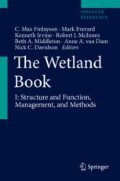Abstract
Mangroves are characteristics of coastlines and occur primarily in the tropics and subtropical but extend to temperate regions. Remote sensing radar and optical and lidar data can be used to provide information on mangrove extent and also biophysical characteristics. Optical data are the most useful for differentiating species type, while radar and lidar data can be used, either singularly or in combination, to retrieve the three-dimensional structure (canopy height profiles, cover, and stem number density). Data from these sensors also provide information on changes in extent and biophysical properties, which can be applied at local to global levels. Lower frequency L-band radar data are particularly useful given their ability to operate regardless of weather and illumination conditions and significant efforts are being made to map the changing extent of mangroves at a global level using these data. Examples of capability are provided for Brazil, Australia, and South America.
References
Fatoyinbo TE, Simard M, Washington-Allen RA, Shugart HH. Landscape-scale extent, height, biomass, and carbon estimation of Mozambique’s mangrove forests with Landsat ETM+ and Shuttle Radar Topography Mission elevation data. J Geophys Res. 2008;113:G02S06.
Fatoyinbo TE, Simard M. Height and biomass of mangroves in Africa from ICESat/GLAS and SRTM. Int J Remote Sens. 2013;34(2):668–81.
Giri G, Ochieng E, Tieszen LL, Zhu Z, Singh A, Loveland T, Masek J, Duke N. Status and distribution of mangrove forests of the world using Earth observation satellite data. Glob Ecol Biogeogr. 2011;20(1):154–9.
Held A, Ticehurst C, Lymburner L, Williams N. High resolution mapping of tropical mangrove ecosystems using hyperspectral and radar remote sensing. Int J Remote Sens. 2003;24:2739–59.
Lucas RM, Mitchell A, Donnelly B, Milne AK, Ellison J, Finlaysson M. Use of stereo aerial photography for assessing changes in the extent and height of mangrove canopies in tropical Australia. Wetl Ecol Manag. 2002;10:161–75.
Lucas RM, Mitchell AL, Rosenqvist A, Proisy C, Melius A, Ticehurst C. The potential of L-band SAR for quantifying mangrove characteristics and change: case studies from the tropics. Aquat Conserv Mar Freshwat Ecosyst. 2007;17(3):245–64.
Lucas R, Finlayson CM, Bartolo R, Rogers K, Mitchell A, Woodroffe CD, Asbridge E, Ens E. Historical perspectives on the mangroves of Kakadu National Park. Marine Freshw Res. 2017. Published online early 5 December 2017 https://doi.org/10.1071/MF17065.
Mitchell AL, Lucas RM, Donnelly BE, Pfizner K, Milne AK, Finlayson M. A new map of mangroves for Kakadu National Park, Northern Australia, based on stereo aerial photography. Wetl Ecol Manag. 2007;17:446–67.
Nascimento Jr WR, Souza-Filho PWM, Proisy C, Lucas RM, Rosenqvist A. Mapping changes in the largest continuous Amazonian mangrove belt using object-based classification of multisensor satellite imagery. Estuar Coast Shelf Sci. 2013;117:83–93.
Rosenqvist A, Shimada M, Watanabe M. ALOS PALSAR: a pathfinder mission for global-scale monitoring of the environment. IEEE Trans Geosci Remote Sens. 2007;45(11):3307–16.
Simard M, Zhang KQ, Rivera-Monroy VH, Ross MS, Ruiz PL, Castaneda-Moya E, Twilley RR, Rodriguez E. Mapping height and biomass of mangrove forests in Everglades National Park with SRTM elevation data. Photogramm Eng Remote Sens. 2006;72(3):299–311.
Simard M, Rivera-Monroy VH, Mancera-Pineda JE, Castaneda-Moya E, Twilley RR. A systematic method for 3d mapping of mangrove forests based on Shuttle Radar Topography Mission elevation data, ICESat/GLAS waveforms and field data: application to Cienaga Grande De Santa Marta, Colombia. Remote Sens Environ. 2008;112:2131–44.
Spalding M, Kainuma M, Collins L. World atlas of mangroves. 2 ed. London: Earthscan; 2010. p. 336.
Author information
Authors and Affiliations
Corresponding authors
Editor information
Editors and Affiliations
Rights and permissions
Copyright information
© 2018 Springer Science+Business Media B.V., part of Springer Nature
About this entry
Cite this entry
Lucas, R., Fatoyinbo, L., Simard, M., Rebelo, LM. (2018). Remote Sensing of Wetland Types: Mangroves. In: Finlayson, C.M., et al. The Wetland Book. Springer, Dordrecht. https://doi.org/10.1007/978-90-481-9659-3_305
Download citation
DOI: https://doi.org/10.1007/978-90-481-9659-3_305
Published:
Publisher Name: Springer, Dordrecht
Print ISBN: 978-90-481-3493-9
Online ISBN: 978-90-481-9659-3
eBook Packages: Biomedical and Life SciencesReference Module Biomedical and Life Sciences

